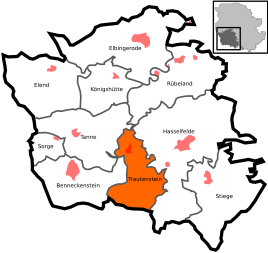Trautenstein
|
Trautenstein
City of Oberharz am Brocken
|
|
|---|---|
| Coordinates: 51 ° 41 ′ 7 ″ N , 10 ° 47 ′ 10 ″ E | |
| Height : | 460 m above sea level NN |
| Area : | 1.93 km² |
| Residents : | 600 |
| Population density : | 311 inhabitants / km² |
| Incorporation : | January 1, 2002 |
| Incorporated into: | Hasselfelde |
| Postal code : | 38899 |
| Area code : | 039459 |
|
Location of Trautenstein in Oberharz am Brocken
|
|
|
View from Dammbachtal to Trautenstein
|
|
Trautenstein im Harz is a district of the town of Oberharz am Brocken in the Harz district in Saxony-Anhalt .
Geographical location
Trautenstein is located in the Lower Harz in the Harz / Saxony-Anhalt Nature Park . It is located directly north of the mouth of the Dammbach in the Rappbode and near the southern end of the Rappbodevorsperre . About 3.3 km south of the village is the Carlshaushöhe , also called Bärenhöhe , on the 626.3 m high summit of the Carlshausturm , a radio and observation tower of the Harz narrow-gauge railway .
Larger places in the vicinity are Braunlage , Bad Lauterberg , Bad Harzburg (all Lower Saxony) and Blankenburg , Wernigerode and Hasselfelde (all Saxony-Anhalt). The most important connection road is the federal road 242 leading through Trautenstein in the direction of Hasselfelde or Braunlage .
history
The place was first mentioned in 1448. It has developed from a traditional mining and forestry village to a tourist destination. The Heimatstube contains exhibits about the eventful history of the place. The name of the place Trautenstein goes back to the "Druidenstein" or "Drudenstein", a place of worship, sacrifice, execution and marriage of a pagan clan in the Middle Ages.
In October 1607, a large part of the place burned down.
In 1701 the baroque half-timbered church with a wooden barrel vault and horseshoe gallery was completed, and in 1834 it received an Engelhardt organ with the free-standing console and eleven stops.
In 1807 the place was incorporated into the Kingdom of Westphalia created by Napoleon . Trautenstein became a municipality in the canton of Hasselfelde . The canton formed part of the Blankenburg district in the Saale department . After the dissolution of the Kingdom of Westphalia in 1813 and the constitution of the Duchy of Braunschweig , the state administration was reorganized. Trautenstein became part of the Hasselfelde office in the Duchy of Braunschweig.
In 1979, parts of the DEFA fairytale film Snow White and Rose Red were filmed on and in Rappbode to the north .
On January 1, 2002, Trautenstein was incorporated into Hasselfelde and has been part of Oberharz am Brocken since the town of Oberharz am Brocken was founded on January 1, 2010.
climate
coat of arms
Blazon : "In gold a green fir tree on a curved green shield base, each accompanied by a black miner's toughness."
In 1995 the municipal council commissioned the Magdeburg municipal heraldist Jörg Mantzsch to develop a coat of arms. The basis was a coat of arms that had already been used, but was not approved because it was heraldically incorrect. Mantzsch neglected some symbols and limited the coat of arms to its reference to the natural environment and to mining as the main branch of the economy.
The colors of the Trautenstein district are green and yellow.
Culture and sights
Radio and observation tower of the Harz narrow-gauge railway on the Bärenhöhe at Carlshaus, trageburgruine with a view of the Rappbode-Vorsperre on the Harzer Hexenstieg
In 1701 a baroque half-timbered church with a wooden barrel vault and a horseshoe gallery was built on the "Druidenstein" . The font is a classical Harz cast iron from 1830 and designed in the form of an ancient altar . For the 300th anniversary of the inauguration, the church was extensively renovated and now shines in new splendor with the starry sky. The restored Engelhardt - organ with the freestanding console and the eleven registers from 1834 is playable again in 2008.
There is a commemorative plaque with his name on the birthplace of the building councilor and railway director Albert Schneider (1838–1910), today's parish office in Trautenstein, and in 2010 Bergstrasse was renamed Albert-Schneider-Strasse in his honor stands.
The Heimatstube in the village community center gives an insight into the history of Trautenstein since the place was first mentioned.
Sports
Recreational sports in summer include hiking, sunbathing in the natural pond in the Dammbachtal, cycling on the new bike path from Trautenstein to Hasselfelde, fishing at the dam, Nordic walking, horse riding, carriage rides and in winter horse-drawn sleigh rides, cross-country skiing, tobogganing and winter hiking. The trails are set up by the Loipenverbund Harz eV association. The Harzklub branch association Trautenstein organizes hikes with members throughout the year.
Regular events
A highlight in summer is the annual three-day shooting festival. Other festivities in the village are the annual football tournament in June, the fire brigade festival for the Raven Cup , the fair in August, the Oktoberfest, the St. Martin's parade and the festival of lights in winter and other events in the village community center on Schützenplatz.
Sons and daughters of the place
- Albert Schneider (1833–1910), building advisor and railway director
- Karl Gronau (1889–1950), university professor
- Theodor Heinrich Wilhelm von Lerche (1791–1847), personal physician to Tsar Nicholas I Pavlovich









